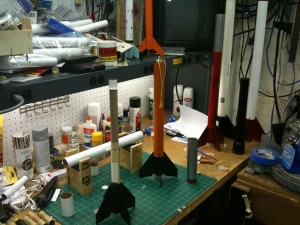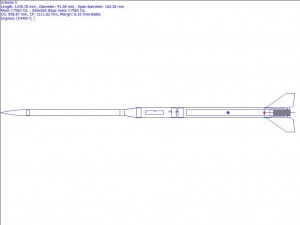The plans for the Artemis V launch vehicle are nearing completion. The layout is very similar to what was being tested on the Aquila booster tests. This arrangement will be useful with upcoming tests using radio telemetry payloads.
The Artemis V uses a standard Artemis booster section, and a “long” payload stage. The standard parachute bay is being proposed for use with this new configuration. Tests are scheduled for later this year.
This is the first of the new payload stages to be shown. Work is being done on a “camera” payload stage for aerial photography from higher altitudes (2,000 feet), and a series of general flight data recorder payloads are also in the works as well.
None of our rockets have ever flown any higher than 1200 feet (The Aquila booster’s maximum range), so the higher altitude launches will be ones to watch for! Currently, the Artemis boosters are limited to a range just below 1,000 feet during the flight trials stage of the program. By late summer, plans are in the works to send the launch vehicle to around 1500 feet, and by winter, we will go for beyond 2,000 feet at the O’Reily field.
A busy year is shaping up for the Artemis booster program!
**********************************************
Artemis Launch Vehicle configuration data.
Artemis 1B – Flight trials, small payloads
Artemis 1C – Camera payloads
Artemis 1D – Telemetry payload
Artemis V – “long configuration” – radio telemetry payloads
(((( ))))
(April 24, 2010 – Harmon Flying Field)
The scheduled flight tests of the Artemis 1B booster rockets were scrubbed today due to the unpredictability of the weather…
The next scheduled launch is May 15th at the Pitchman launch site in Mantua.
The Artemis missions now have flight designations. ARS-5 will be the next mission.
Details to come.
(((( ))))
March 27, 2010 – Harmon flying field
The last of the test flights of the Aquila booster project avoided disaster “by a hair” and ended on a successful note.
The “Phew” moment came shortly after liftoff when part of the igniter plug somehow became lodged in the motor nozzle, and threatened to cause a catastrophic failure of the motor…thankfully, that didn’t happen and the Aquila flew to its designated altitude of 1300 feet, returning safely with no structural damage – concluding the tests of the “long” rocket configuration.
The Aquila “long” configuration was designed to test a booster rocket with an extremely long payload with the purpose of gathering flight stability and structural integrity data to be used in designing the long payload sections to be used on the Artemis medium booster project. This configuration for the Artemis will be used for real time radio telemetry tests scheduled to happen during the summer of 2011. In that particular configuration, the launch system will be named “Artemis V”.
The Aquila booster is now cleared for regular low power payload flights.
((( )))
Production on multiple Artemis mid-power boosters has begun! The second Artemis booster (orange) is in its final phases of completion while a third one is under construction.

Artemis booster # 3 (foreground) under construction. Artemis booster #2 (orange) - later designated as booster 3- nearing completion. In the background (red & silver) is Artemis booster #1
There will be a total of four boosters built, three of which will be in regular service while the first one, which made its first flights on March 27th, will see limited use, and will be used primarily to test payload sections to be used later this summer.
Flight tests for the second Artemis booster are scheduled for April 24 2010, weather permitting.
First flight test results
Results from the first flight tests of the Artemis booster shows the booster coming through mostly fine, though a closer inspection revealed some buckling if the “stuffer tube” which holds the first half of the ejection baffle. This could have occurred during the first launch where part of the experimental motor mount system failed – though it did not pose any problem to the flight other than the motor being ejected shortly after parachute deployment.
Changes were made to the design of the newer Artemis boosters under construction to correct for this issue.
–(((( ))))–

